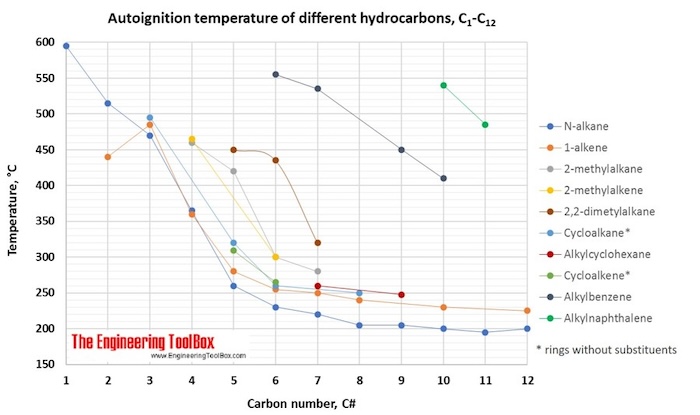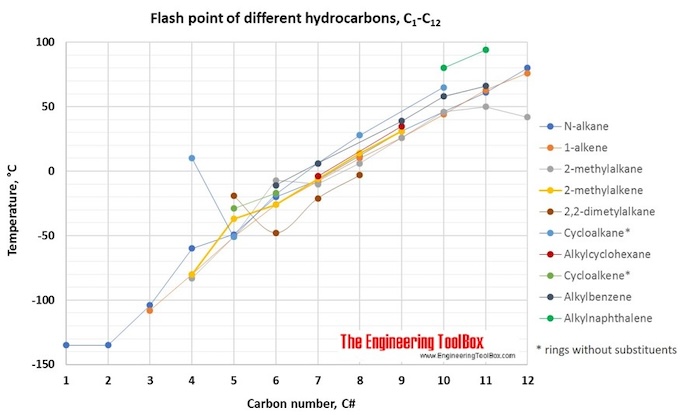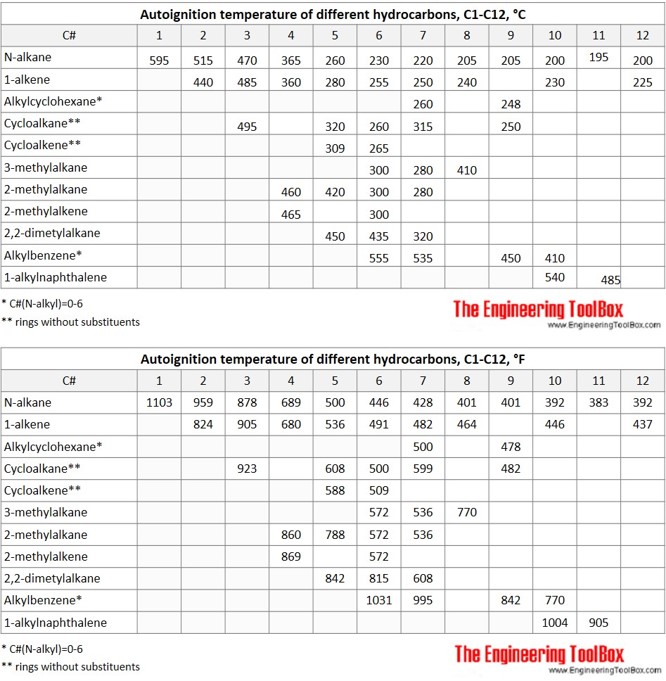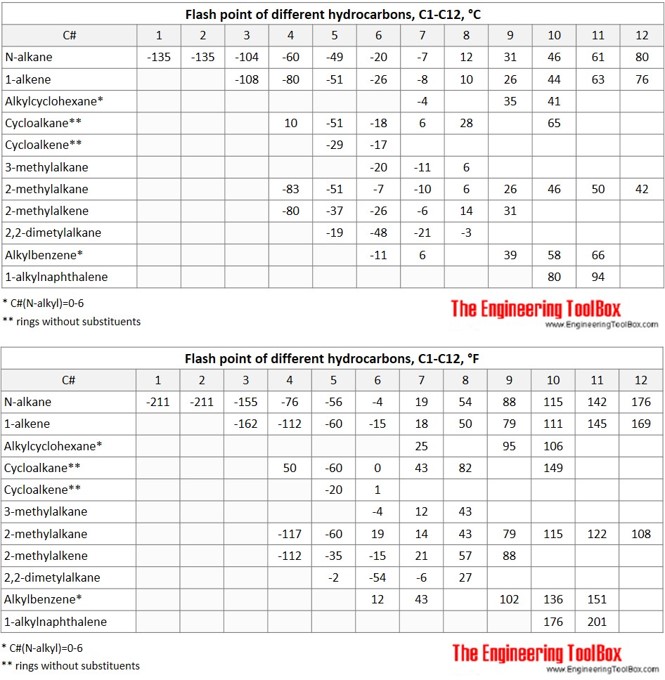Hydrocarbons - Autoignition Temperatures and Flash Points
Autoignition temperatures and flash points (°C and °F) of different types of hydrocarbons with varying carbon numbers up to C12.
The tables and figures below show the autoignition temperature (AIT) and flash point (FP) for different hydrocarbons. In the figures, the AIT and FP are shown as function of number of carbon atoms in the hydrocarbons, which are grouped as n-alkanes, 1-alkenes, 2-methylalkanes, 3-methylalkanes, 2,2,dimethylalkanes, 2-methylalkenes, cycloalkanes, alkylcyclohexanes, cycloalkenes, alkylbenzenes and alkylnaphthalenes.
- Autoignition temperature = kindling point
- is the temperature at which a material spontaneously ignites in a normal atmosphere without an external source of ignition.
- is the temperature required to supply the activation energy for combustion
- is usually applied to combustible fuel mixtures
- Flash point - the lowest temperature at which vapour of a volatile material can be ignited whit an ignition source present
- Values of autoignition temperature are generally higher than flash point, as given for pure hydrocarbons in the tables and figures below.
- With an increase in pressure the autoignition temperature decreases. This is particularly important from a safety point of view when hydrocarbons are compressed.
- Hydrocarbons with high vapor pressures (lighter compounds) have low flash points. Generally, flash point increases with an increase in boiling point.
- Flash point is an important parameter for safety considerations, especially during storage and transportation of volatile petroleum products (i.e., LPG, light naphtha, gasoline) in a high-temperature environment. The surrounding temperature around a storage tank should always be less than the flash point of the fuel to avoid possibility of ignition.
- Flash point should not be mistaken with fire point, which is defined as the minimum temperature at which the hydrocarbon will continue to burn for at least 5 s after being ignited by a flame.
- Temperature classification of equipment in hazardous areas are related to surrounding substances auto-ignition temperature.
See also Flash Point - Fuels


| IUPAC name | Common name | Flash point | Autoignition temp | ||
|---|---|---|---|---|---|
| °C | °F | °C | °F | ||
| Benzene | Benzol | -11 | 12 | 555 | 1031 |
| But-1-ene | 1-butene, 1-butylene, Ethylethylene | -80 | -112 | 360 | 680 |
| But-2-ene | Cis-2-butene | -72 | -98 | 325 | 617 |
| But-2-ene | Trans-2-butene | -73 | -99 | 324 | 615 |
| 1,2-butadiene | <-50 | <-58 | 340 | 644 | |
| 1,3-butadiene | Biethylene, divinylbutadiene, pyrrolylene, vinylethylene | -85 | -121 | 415 | 779 |
| N-butane | -60 | -76 | 365 | 689 | |
| Butylbenzene | 58 | 136 | 410 | 770 | |
| Butylcyclohexane | 41 | 106 | |||
| Butylcyclopentane | 32 | 90 | |||
| 1-butyne | Ethylacetylene | <-14 | <6.8 | ||
| 2-butyne | Crotonylene | -25 | -13 | ||
| Cyclobutane | <10 | <50 | |||
| Cyclodecane | 65 | 149 | |||
| Cycloheptane | 6 | 43 | |||
| 1,3-cyclohexadiene | -8 | 18 | |||
| Cyclohexane | Hexamethylene, hexanaphthene | -18 | 0 | 260 | 500 |
| Cyclohexene | -17 | 1 | 265 | 509 | |
| Cyclohexylbenzene | 99 | 210 | |||
| Cyclooctane | 28 | 82 | 250 | 482 | |
| Cyclopentane | -51 | -60 | 320 | 608 | |
| Cyclopentene | -29 | -20 | 309 | 588 | |
| Cyclopropane | Trimethylene | 495 | 923 | ||
| o-cymene | 53 | 127 | |||
| N-decane | 46 | 115 | 200 | 392 | |
| 2-decanol | 85 | 185 | |||
| 1-decene | 44 | 111 | 230 | 446 | |
| 2,3-dimethyl-2-butene | Tetramethylethylene | <-20 | <-4 | 400 | 752 |
| 1,2-dimethylbenzen | orto-xylene | 30 | 86 | 465 | 869 |
| 1,3-dimethylbenzen | meta-xylene | 25 | 77 | 540 | 1004 |
| 1,4-dimethylbenzen | para-xylene | 25 | 77 | 540 | 1004 |
| 2,2-dimethylbutane | Neohexane | -48 | -54 | 435 | 815 |
| 2,3-dimethylbutane | Diisopropyl | -29 | -20 | 415 | 779 |
| 2,2-dimethylhexane | -3 | 27 | |||
| 2,2-dimethylpentane | -21 | -6 | 320 | 608 | |
| 3,3-dimethylpentane | -15 | 5 | 320 | 608 | |
| 2,3-dimethylpentane | -12 | 10 | 330 | 626 | |
| 2,4-dimethylpentane | <-20 | <-4 | 325 | 617 | |
| 2,2-dimethylpropane | Neo-pentane, trimethylethane | -19 | -2 | 450 | 842 |
| Diphenyl methane | 130 | 266 | |||
| N-docosane | 211 | 412 | |||
| Docosanoic acid | Behenic acid | 176.3 | 349 | ||
| N-dodecane | 80 | 176 | 200 | 392 | |
| Dodecanoic acid | Lauric acid | 134.1 | 273 | ||
| 1-dodecanol | Lauryl alcohol | 119 | 246 | ||
| 1-dodecene | 76 | 169 | 225 | 437 | |
| N-eicosane | 187 | 369 | |||
| Ethane | -135 | -211 | 515 | 959 | |
| Ethene | Ethylene | 440 | 824 | ||
| Ethylbenzene | 15 |
59 |
|||
| Ethylcyclohexane | 22 |
72 |
|||
| Ethylcyclopentane | -4 |
25 |
|||
| Ethyne | Acetylene | 305 | 581 | ||
| N-heptacosane | 269 | 516 | |||
| N-heptadecane | 148 | 298 | |||
| N-heptane | -7 | 19 | 220 | 428 | |
| 2-heptanol | 59 | 138 | |||
| 1-heptene | 1-heptylene | -8 | 18 | 250 | 482 |
| Cis-2-heptene | -6 | 21 | |||
| Trans-2-heptene | -1 | 30 | |||
| Cis-3-heptene | -7 | 19 | 260 | 500 | |
| Trans-3-heptene | -6 | 21 | |||
| 1-heptyne | -2 | 28 | 245 | 473 | |
| N-hexadecane | 135 | 275 | |||
| N-hexane | Hexane | <-20 | <-4 | 230 | 446 |
| 3-hexanol | 41.7 | 107 | |||
| 1-hexene | -26 | -15 | 255 | 491 | |
| Cis-2-hexene | -25 | -13 | 244 | 471 | |
| Trans-2-hexene | -25 | -13 | 244 | 471 | |
| Hexylbenzene | 80 | 176 | |||
| 1-hexyne | -20 | -4 | 263 | 505 | |
| 3-hexyne | -14 | 7 | |||
| Isobutylbenzene | 55 | 131 | |||
| Isopropylbenzene | Cumene | 31 | 88 | 420 | 788 |
| Methane | -135 | -211 | 595 | 1103 | |
| 2-methyl-1,3-butadiene | Isoprene | -54 | -65 | 220 | 428 |
| 2-methyl-1-butene | -37 | -35 | |||
| 3-methyl-1-butene | -58 | -72 | 365 | 689 | |
| 1-Methyl-1-cyclohexene | -4 | 25 | |||
| 4-Methyl-1-cyclohexene | -1 | 30 | |||
| 2-methyl-1-heptene | 14 | 57 | |||
| 2-methyl-1-hexene | -6 | 21 | |||
| 2-methyl-1-octene | 31 | 88 | |||
| 2-methyl-1-pentene | 1-methyl-1-propylethylene | -26 | -15 | 300 | 572 |
| 2-methyl-1-propene | Isobutene, Isobutylene | -80 | -112 | 465 | 869 |
| 2-methyl-2-butene | Trimethylethylene, beta-iso-amylene | -45 | -49 | 290 | 554 |
| Methylbenzene | Toluene, toluol | 6 | 43 | 535 | 995 |
| 2-methylbutane | Iso-pentane | -51 | -60 | 420 | 788 |
| Methylcyclohexane | Heptanaphthene | -4 | 25 | 260 | 500 |
| Methylcyclopentane | <-10 | <14 | 315 | 599 | |
| 2-methyldecane | 50 | 122 | |||
| 2-methylheptane | 6 | 43 | |||
| 3-methylheptane | 6 | 43 | 410 | 770 | |
| 4-methylheptane | 6 | 43 | |||
| 2-methylhexane | -10 | 14 | 280 | 536 | |
| 3-methylhexane | -11 | 12 | 280 | 536 | |
| 1-methylnaphthalene | 94 | 201 | 485 | 905 | |
| 2-methylnaphthalene | 98 | 208 | 488 | 910 | |
| 2-methylnonane | iso-decane | 46 | 115 | ||
| 2-methyloctane | isononane, dimethylheptane | 26 | 79 | ||
| 2-methylpentane | iso-hexane, i-caproylhydride | <-7 | <19.4 | 300 | 572 |
| 3-methylpentane | Diethylmethylmethane | <-20 | <-4 | 300 | 572 |
| 2-methylpropane | iso-butane | -83 | -117 | 460 | 860 |
| 2-methylundecane | 42 | 108 | |||
| Naphthalene | 80 | 176 | 540 | 1004 | |
| N-nonadecane | 168 | 334 | |||
| N-nonane | 31 | 88 | 205 | 401 | |
| 2-nonanol | 82.2 | 180 | |||
| 3-nonanol | 79.5 | 175 | |||
| 4-nonanol | 79.5 | 175 | |||
| 1-nonene | 26 | 79 | |||
| N-octadecane | 165 | 329 | |||
| N-octane | 12 | 54 | 205 | 401 | |
| 1-octanol | Capryl alcohol | 81 | 178 | 259 | 497 |
| 1-octene | 1-caprylene | 10 | 50 | 240 | 464 |
| N-pentadecane | 114 |
237 |
|||
| N-pentane | -49 | -56 | 260 | 500 | |
| 1-pentene | n-amylene, propylethylene | -51 | -60 | 280 | 536 |
| Pentylbenzene | Phenylpentane, amylbenzene | 66 | 151 | ||
| 1-pentyne | Propylacetylene | <-20 | <-4 | ||
| Phenanthrene | 171 | 340 | >450 | >842 | |
| Propane | -104 | -155 | 470 | 878 | |
| Propene | Propylene | -108 | -162 | 485 | 905 |
| Propylbenzene | 39 | 102 | 450 | 842 | |
| Propylcyclohexane | 35 | 95 | 248 | 478 | |
| Propylcyclopentane | 16 | 61 | |||
| Propyne | 340 | 644 | |||
| Pyrene | Benzo(def)phenanthrene | 200 | 392 | ||
| Styrene | 32 |
90 |
|||
| N-tetradecane | 100 |
212 |
|||
| N-tridecane | 79 | 174 | |||
| Tridecanoic acid | Tridecylic acid | 139.6 | 283 | ||
| 1,2,3-trimethylbenzene | 51 | 124 | |||
| 1,3,5-trimethylbenzene | Mesitylene, trimethylbenzol | 44 | 111 | 550 | 1022 |
| 2,2,4-trimethylpentane | Iso-octane | -9 | 16 | 410 | 770 |
| N-undecane | 61 | 142 | 195 | 383 | |
| Undecanoic acid | 128 | 262 | |||
| 3-undecanol | 94 | 201 | |||
| 1-undecene | 63 | 145 | |||
| o-xylene | 17 | 63 | |||
| m-xylene | 25 | 77 | |||
| p-xylene | 25 | 77 | |||

<

In oil industry, the following terms for the different hydrocarbons are used:
Paraffins: Alkenes - lineare, saturated molecules, straight or branched chains
Olefins: Alkenes - lineare, unsaturated molecules, straight or branched chains (these are normally not present in unprocessed crude oil)
Naphthenes: Cycloalkanes - saturated ring structures, or cycloalkenes - partly saturated ring structures, with or without substituents connected to the ring
Aromatics: Unsaturated 6-ring structures (3 doble bounds in one ring), with or without substituents



